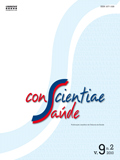Effects of Hydrotherapy on the Balance of Individuals with Parkinson’s disease
DOI:
https://doi.org/10.5585/conssaude.v9i2.2108Keywords:
Hydrotherapy, Parkinson disease, Postural balance.Abstract
Introduction: The Parkinson’s disease (PD) is a neurodegenerative disease that leads to progressive loss of neurons in the substantia nigra, resulting in dysfunctions in the patterns of movement. Objective: To analyze the effects of hydrotherapy in balance of individuals with PD. Method: Seven individuals (54.00 ± 6.08 years old), with were PD studied. The evaluation of the functional balance was performed by the Berg Balance Scale (BBS) and Timed up and Go test (TUGT) before and after the protocol of hydrotherapy. The protocol was applied three times week (40 minutes of duration) during four weeks. Results: It was observed a significant increase in the BBS scores (25.3 ± 10.0 vs. 37.0 ± 8.5) and a reduction of the time in TUGT (13.2 ± 1.8 vs. 11.4 ± 1.7; p < 0.05) after the program of hydrotherapy. Conclusion: The protocol hydrotherapy promoted an improvement in balance of individuals with PD.Downloads
Downloads
Published
2010-08-10
How to Cite
1.
Andrade CHS de, Silva BF da, Corso SD. Effects of Hydrotherapy on the Balance of Individuals with Parkinson’s disease. Cons. Saúde [Internet]. 2010 Aug. 10 [cited 2025 Jun. 19];9(2):317-23. Available from: https://periodicos.uninove.br/saude/article/view/2108
Issue
Section
Cases studies
License
Copyright (c) 2010 ConScientiae Saúde

This work is licensed under a Creative Commons Attribution-NonCommercial-ShareAlike 4.0 International License.
Views
- Abstract 1111
- PDF (Português (Brasil)) 735







